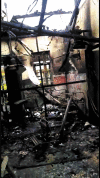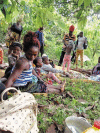Armed conflict, a neglected determinant of childhood vaccination: some children are left behind
- PMID: 31809650
- PMCID: PMC7482736
- DOI: 10.1080/21645515.2019.1688043
Armed conflict, a neglected determinant of childhood vaccination: some children are left behind
Abstract
Vaccination is an indisputable intervention that has tremendously mitigated the global burden of vaccine-preventable diseases (VPDs). The number of armed conflicts globally seems to be at an all-time high, with devastating effects on vaccination coverage. This paper will examine how armed conflicts affect childhood vaccination and lead to the reemergence and spread of VPDs. Unarguably, socioeconomic factors, population demographics, the apparent long vaccination timetable, multiple vaccine doses, lack of trust in vaccination processes and the rumor of the adverse effects of some vaccines unnerve some parents and create a puzzle. By bringing under the global floodlight, the impact of armed conflicts which contextually affect vaccination coverage, this article will help strengthen the advocacy for vaccination, and call for the fortification of existing treaties on the rule of engagement during conflicts. In order to eliminate or eradicate VPDs, strategies to reach children that are left behind during conflicts is paramount.
Keywords: Global Alliance for Vaccination and Immunization (GAVI); Vaccination; benefits; conflicts; determinants; immunization; leave no child behind; vaccine prventable diseases (VPDs).
Figures





Similar articles
-
Burden of vaccine-preventable diseases, trends in vaccine coverage and current challenges in the implementation of the expanded program on immunization: A situation analysis of Cameroon.Hum Vaccin Immunother. 2022 Dec 31;18(1):1939620. doi: 10.1080/21645515.2021.1939620. Epub 2021 Jul 1. Hum Vaccin Immunother. 2022. PMID: 34197271 Free PMC article. Review.
-
The Impact of Conflict on Immunisation Coverage in 16 Countries.Int J Health Policy Manag. 2019 Apr 1;8(4):211-221. doi: 10.15171/ijhpm.2018.127. Int J Health Policy Manag. 2019. PMID: 31050966 Free PMC article.
-
Barriers for vaccination of healthcare workers.Hum Vaccin Immunother. 2021 Sep 2;17(9):3073-3076. doi: 10.1080/21645515.2021.1904760. Epub 2021 Apr 27. Hum Vaccin Immunother. 2021. PMID: 33905303 Free PMC article.
-
Towards adult vaccination in India: a narrative literature review.Hum Vaccin Immunother. 2020 Apr 2;16(4):991-1001. doi: 10.1080/21645515.2019.1682842. Epub 2019 Dec 2. Hum Vaccin Immunother. 2020. PMID: 31746661 Free PMC article. Review.
-
Exploring the spatial heterogeneity in different doses of vaccination coverage in India.PLoS One. 2018 Nov 28;13(11):e0207209. doi: 10.1371/journal.pone.0207209. eCollection 2018. PLoS One. 2018. PMID: 30485291 Free PMC article.
Cited by
-
Exposure to conflict and child health outcomes: evidence from a large multi-country study.Confl Health. 2022 Oct 10;16(1):52. doi: 10.1186/s13031-022-00483-9. Confl Health. 2022. PMID: 36217162 Free PMC article.
-
Not only vaccine hesitancy, but also vaccination campaign hesitancy drives measles epidemics in conflict-torn eastern DR Congo.Confl Health. 2024 Feb 1;18(1):14. doi: 10.1186/s13031-024-00569-6. Confl Health. 2024. PMID: 38302997 Free PMC article.
-
Association Between Subnational Vaccine Coverage, Migration, and Incident Cases of Measles, Mumps, and Rubella in Iraq, 2001-2016.Front Public Health. 2022 Jan 20;9:689458. doi: 10.3389/fpubh.2021.689458. eCollection 2021. Front Public Health. 2022. PMID: 35127606 Free PMC article.
-
Factors associated with the intention of Syrian adult population to accept COVID19 vaccination: a cross-sectional study.BMC Public Health. 2021 Jul 4;21(1):1310. doi: 10.1186/s12889-021-11361-z. BMC Public Health. 2021. PMID: 34218807 Free PMC article.
-
Burden of vaccine-preventable diseases, trends in vaccine coverage and current challenges in the implementation of the expanded program on immunization: A situation analysis of Cameroon.Hum Vaccin Immunother. 2022 Dec 31;18(1):1939620. doi: 10.1080/21645515.2021.1939620. Epub 2021 Jul 1. Hum Vaccin Immunother. 2022. PMID: 34197271 Free PMC article. Review.
References
-
- Immunization programme [Internet]. Unicef.org; 2019. [accessed 2019 September2]. https://www.unicef.org/immunization.
-
- Barnett-Vanes A. Armed conflict, medical training and health systems. Med Conflict Survival. 2016. January 2;32(1):30–39. - PubMed
MeSH terms
Substances
LinkOut - more resources
Full Text Sources
Medical
Miscellaneous
